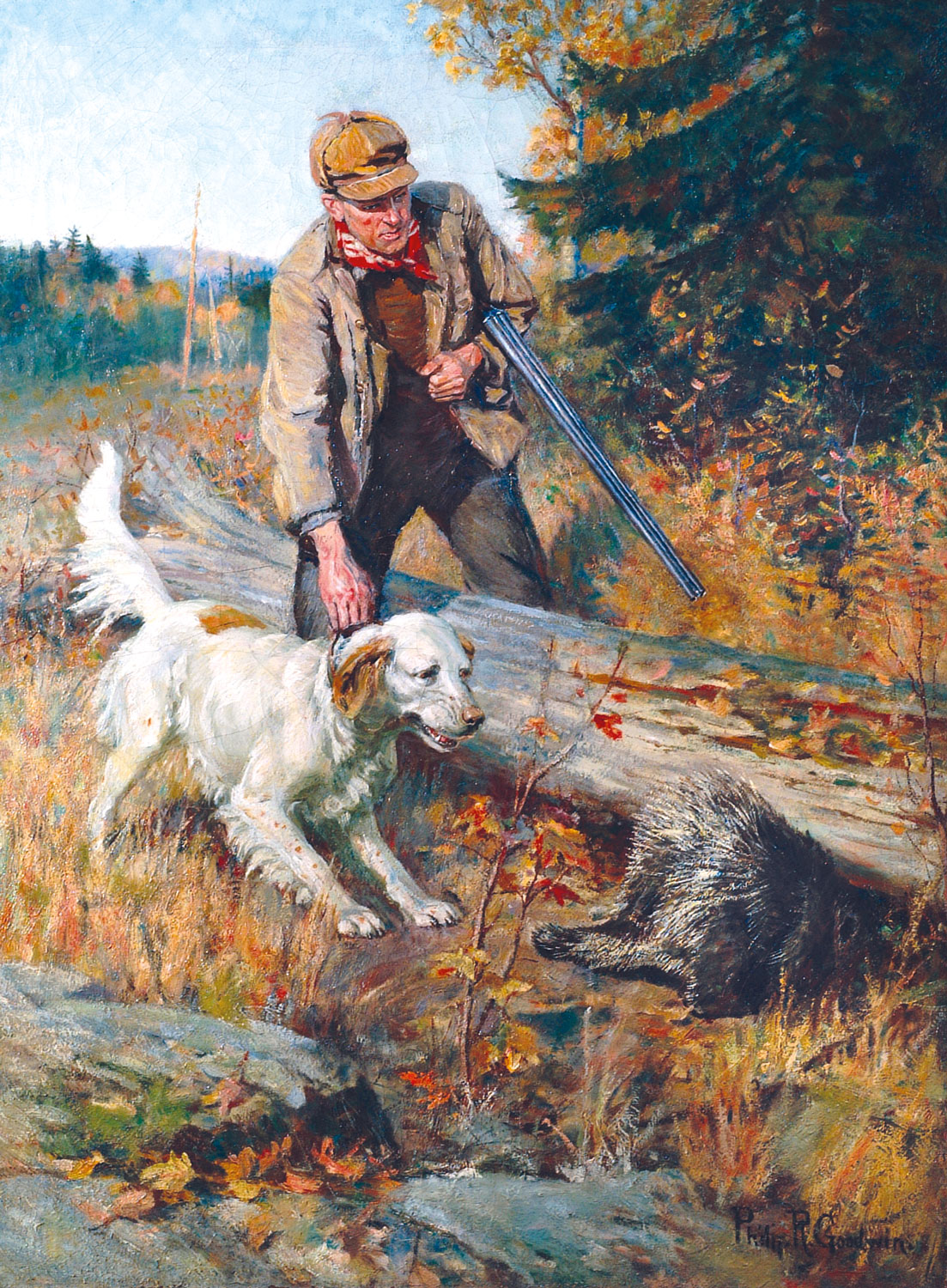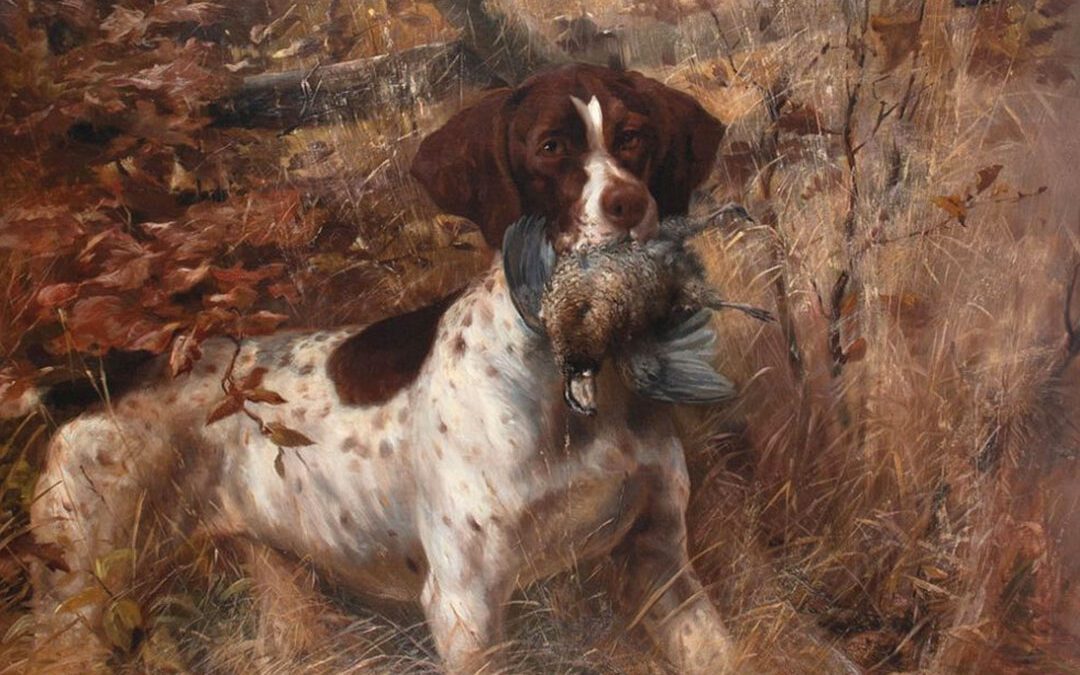It’s so perfect, in fact, that most serious quail hunters would rather go afield without a shotgun than without a dog. Some veteran bird hunters pay exorbitant lease prices to exercise their dogs. Oh, they may shoot a bird now and then, but they shoot mostly because the dog expects it. They’re like a ballet dancer who no longer pirouettes but lavishly supports the arts, giving young dancers a stage to pursue their passion.
At the Westminster Dog Show, there’s a sporting breed category that includes pointing dogs, though the show pointers and setters are so poofed up they bear little resemblance to their hard-hunting brethren. Put a Westminster pointer in a west Texas quail field and it would look as out of place as Paris Hilton working as a Sonic carhop.
One weekend during hunting season I walked down the center aisle of a kennel loaded with real pointing dogs. The dogs raised a deafening din as they lunged around their wire enclosures with such enthusiasm that centrifugal force might have held them in place had they known to run straight up the side and across the enclosed top.
They weren’t clamoring to be fed. They were aching with every fiber of their being to be taken hunting. Everything about their body language delivered the same message. “Put me in coach! Pick me! Pick me! I can find those birds!”
Bird dogs will endure indignities and hardships to make the A-team. Turn ’em upside down on a booting table and they’ll quiver impatiently as you tape rubber boots on their feet to protect them from grass burrs. Strap a beeper collar around their necks so you can locate them in dense cover and they’ll ignore the intrusive electronic beep, a sound as annoying as the backing-up claxon sound emitted by heavy equipment.
I’ve seen bird dogs perforated by porcupine quills, bleeding from thorns, swollen from snakebites, hobbled by burrs, ripped open by barbed-wire fences, shot by careless hunters, gassed by skunks, mauled by feral hogs and exhausted from running the equivalent of a marathon three days in a row.
All they asked in return was a dry, relatively warm place to sleep, a meager ration of dog food and enough clean water to slack their thirst. The very next day, they were anxious to do it all over again.
I have been privileged to follow behind many good pointing dogs. T. Boone Pickens once had a pointer named Ethel, but her name should have been spelled Ethyl, as in high-octane.

Painting by Robert E. Lougheed – courtesy The Remington Collection.
Ethel had the advantage of finding birds on one of the greatest quail ranches in existence, but so did her kennelmates. Ethel found more quail than the other dogs and she looked better doing it. She ran with an elegant gait that made it seem like she was floating over the sandy soil. Once birds were located, Ethel had an uncanny sense of how to trail them without bumping the covey. I don’t think I ever saw her bump birds by pushing them too hard.
When the iconic Pickens was asked by a business reporter when he first realized he was rich, the lifelong quail hunter’s answer no doubt surprised his interviewer. “I knew I was rich,” he said, “when I realized that I owned thirty-five bird dogs.”
Any good bird dog can smell quail, but the innate ability to work birds well comes from within the dog. It cannot be taught. It certainly can’t be passed along by a guy with a whistle and no idea where the birds went in the first place.
If Ethel was the best English pointer I ever saw, then Jack is certainly the best setter. Jack belongs to quail-hunting guide John Cox, or vice versa. According to Cox, a horseback specialist who treats his horses like dogs, his dogs like children and his hunters like barbarians, Jack was not a prodigy.
“When Jack was a pup, he couldn’t pass up a porcupine,” recalled Cox, as our horses followed the muscular, rangy setter across the sandhills of the Oklahoma Panhandle. “I thought the dog was stupid and he’d wind up blinded by porcupine quills.

Out Pointed by Philip R. Goodwin – courtesy The Remington Collection.
“Then one day Jack had an epiphany. He pointed five coveys in a row. Just after that he came across another porcupine. He thought about tackling that porcupine, but it was like a light came on in his head and he suddenly knew what he was supposed to do. He left the porcupine and looked for more quail. He’s never tangled with another porcupine.”
Cox lets Jack run big because the graceful setter is a team player. Also, because arguing with Jack about where he should be hunting would be the canine equivalent of arguing string theory with Stephen Hawking. Jack slows his ground-gobbling pace and stops in a sort of tentative point, tail wagging, looking across the hill toward our horses.
“What’s he doing?” I ask, unaccustomed to seeing a tentative point from the champion bird finder.
“Aw, he’s telling us there’s a covey down the ridge from him,” said Cox. “He’ll wait for us to get there, then he’ll pin them down.”
We kick the horses into a lope and quickly close the distance to Jack, still wagging and looking over his shoulder. When we are within 50 yards of the dog, he starts forward into the wind, moving cautiously for nearly 100 yards until he freezes in a point that leaves no doubt the quail are right under his nose.
On numerous occasions I’ve watched Jack run with various brace-mates and the result was always the same. The other dog was on Jack’s team and occasionally pointed a covey. In other strings, Jack’s partner might have been the MVP (most valuable pointer). But running with Jack is like swimming on Michael Phelps’ team. There’s no doubt who’s the star of this show. Jack’s running-mate is like Tonto to the Lone Ranger, Chester to Matt Dillon, Scottie Pippen to Michael Jordan. Jack is so good Cox sometimes wonders if his running-mates are demoralized just to be on the ground with a dog they have no chance of beating.
Here’s another thing you can’t help but wonder after seeing a dog like Jack or Ethel. Why would a scientist waste time cloning sheep? Sheep look identical and seem to reproduce just fine, all on their own. If we’re going to clone anything, for God sakes, let’s clone these great bird dogs! At the very least, let’s set up a loaner program so every quail hunter has a chance to hunt with a great dog.
I once hunted with a true southern gentleman named Ben Parham. Ben is a builder in LaGrange, Georgia, and speaks with a soft southern drawl. He grew up hunting birds with his father during a time when wild quail were plentiful in rural Georgia. Ben recalled a wonderful story that his dad told about growing up in a small Georgia town where it seemed that everybody owned a good bird dog. There were plenty of quail and most of the dogs were at least competent because they got enough work on wild birds.
On Saturday mornings, Ben’s father told him, any hunter who didn’t have a dog could drive to downtown around 8 a.m., where there would usually be a bird dog or two roaming the square. At that hour, it was clear that the dog’s owner had to work or had some kind of family business to take care of and wasn’t hunting that day, so the dogs were allowed to drift downtown, like migrant workers awaiting a day job.
It was common practice just to open your car door and load up a likely looking bird dog. You’d hunt the loaner all day, then bring it back to the square and let it out when the hunt was over. It was customary to stop and buy the dog a hamburger or some other juicy treat as payment for a job well done. Most bird dogs are that way. They’ll hunt for anybody who will take them to a bird field.
There are plenty of wonderful hunting breeds. After spending ten years in the southeast Texas marshes, I have a special affinity for Labrador retrievers, which also happen to be one of the most popular pet breeds in America. Labs are the linebackers among the hunting dogs, but many lack the staying power of a good pointer or a setter.
Bird dogs are the true athletes among hunting dogs. As lean as a Kenyan distance runner, they can gallop across enormous chunks of rugged real estate, sifting the breeze for the subtle scent of their quarry. Ever hold a dead quail under your nose to try and determine what the dog smells?
I have. Unless a bird is gut-shot, it has no odor that I can detect, yet I’ve seen a dog on a humid day with a gentle breeze turn 50 yards downwind from where a single quail flew into cover and unerringly approach the single, then becoming ever more cautious as the scent strengthened – “getting birdy” in bird-hunting parlance – until the dog was standing, stiff as a statue, tail erect, body aquiver.
That, my friend, is what they call a pointing dog. Walk past that dog’s nose and keep your wits about you. There’s a very good chance that a quail is about to erupt from the cover, meaning the dog has done his job and now it’s up to you.
Shoot accurately and the bird dog may even retrieve your prize and fetch it to hand. Retrieving is a parlor trick that real bird dogs reluctantly learn. Most pointing dogs are specialists. It’s their job to find birds and they’re anxious to find more as soon as the bird they’ve pointed has flushed.
You can force a bird dog to retrieve, just like a pro football coach can force a wide receiver to block. They’ll do it grudgingly but just well enough to get by and only because you forced them to retrieve or to block.
Serious quail hunters have learned to keep a well-trained retriever at heel for the mop-up work. They lose fewer dead or crippled birds that way and get into fewer arguments with their wide-ranging specialists.
The most impressive points come when a dog is covering ground like a cheetah coursing a gazelle and suddenly runs downwind of a covey. No Italian or German sports car can go from 30 miles-per-hour to a dead stop as quickly as a bird dog. They whip around in a contorted, mid-stride point, nose toward the birds, body pointed elsewhere.
When a seasoned bird dog disappears into a plum thicket and doesn’t come out on the other side, you’d better go looking for him. You can whistle until you’re blue in the face. If the dog is on point, he’s in a trance-like state that renders him temporarily deaf.
How long he’s willing to stand there depends on the dog and also on the birds. There’s an old joke about a hunter who lost his prize pointer. The next year, while hunting the same cover, he came upon the skeleton of his lost dog, pointing the tightly bunched skeletons of a quail covey.
What makes a dog point birds when its predatory instinct must dictate that it chase them? What makes a bird hold tight to cover when threatened by what must seem like a different-colored coyote?
You may as well ask why planet Earth is a perfect distance from the sun and rotates on its axis in such a way that spring follows winter. It’s too perfect to be random.

